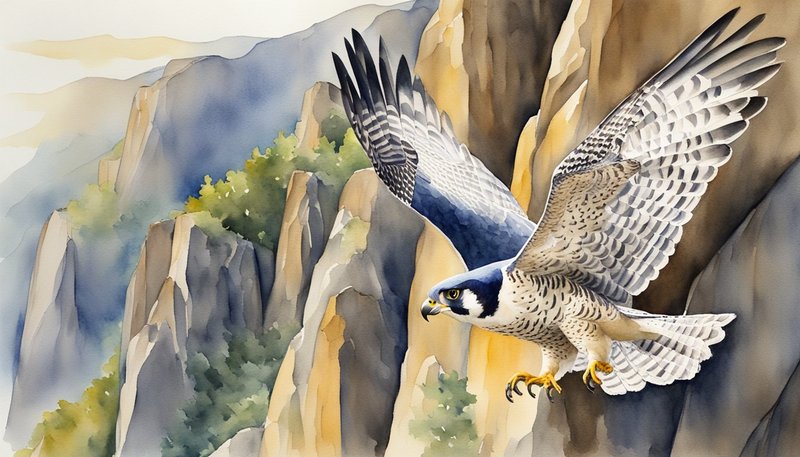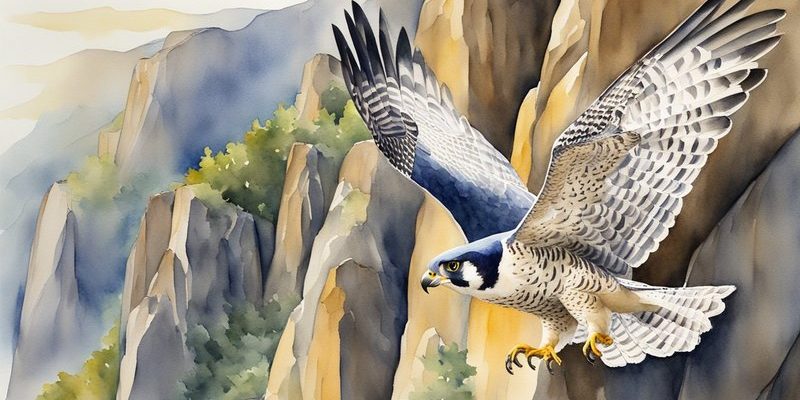
Think of falcons as the ultimate survivors of the bird world. They can be found on every continent except Antarctica, which puts them in a league of their own. Whether they’re perched on a remote cliff or cruising above bustling cities, their habitats are as varied as their impressive skills. In this article, we’ll explore the different types of falcons, their preferred habitats, and how their distribution changes with seasons and geography. So, grab your coffee, and let’s dive into the world of falcons!
Types of Falcons and Their Habitats
Falcons belong to the family Falconidae and consist of about 40 different species. Each type has its own unique habitat preferences. Here’s a quick overview of some of the most common falcon species and where they like to hang out:
- Peregrine Falcon: This is the most well-known falcon, famous for being the fastest bird on the planet. You can find them in urban areas, coastal regions, and mountain ranges.
- American Kestrel: The smallest falcon in North America, kestrels thrive in open fields, grasslands, and even suburban areas.
- Merlin: These small, powerful birds prefer open habitats such as moors and tundras, especially during the breeding season.
- Gyrfalcon: The largest falcon, Gyrfalcons, prefer Arctic and subarctic regions, where they hunt seabirds and small mammals.
Each falcon species has adapted to its environment in unique ways, making them exceptional hunters in their specific regions. Whether soaring over the ocean or darting through a forest, they bring a slice of wildness to their surroundings.
Urban Falcons: Kings of the Concrete Jungle
You might be surprised to learn that many falcons thrive in urban environments. Cities, with their tall buildings and open spaces, offer unique hunting grounds. The Peregrine Falcon, in particular, has made a remarkable comeback in urban settings. They often nest on skyscrapers, mimicking the high cliffs they naturally prefer.
So why do falcons love cities? Well, there’s plenty of food—like pigeons and starlings—making it an attractive hunting spot. Here’s the thing: urban areas can serve as excellent hunting grounds, thanks to the abundance of prey. The pigeons that flutter around city squares? They’re basically fast food for a hungry falcon.
In fact, some cities have even started falconry programs to control pest populations, showcasing the relationship between humans and these birds. It’s a win-win: falcons get food, and we manage our pesky pigeon problems!
Falcon Habitats in the Wild
In the wild, falcons can be found in a wide range of habitats. Here’s a closer look at where they thrive:
Grasslands and Open Fields
Many falcons, such as the American Kestrel, prefer open spaces where they can spot prey from a distance. These habitats feature low vegetation, allowing them to see small animals like rodents and insects easily. Kestrels often hunt by hovering in the air, scanning the ground for movement.
Grasslands are also essential for nest building, as they offer plenty of open areas for their nests and hunting. You might see them perched on fence posts or telephone wires, keeping an eye on their surroundings.
Forests and Wooded Areas
Some falcon species, like the Merlin, prefer habitats with a bit more cover. Forests and wooded areas provide them with the necessary shelter and nesting sites. Here, they can hunt smaller birds that flit among the branches.
Falcons in these areas often use a strategy known as “stooping,” where they dive from a height to catch their prey off guard. The lush environment of the forest offers both cover from larger predators and a safe place to raise their young.
Mountain Ranges and Cliffs
If you venture into mountainous regions, you might catch a glimpse of falcons soaring over rocky cliffs and ravines. The Peregrine Falcon is particularly fond of these habitats. They nest on steep cliffs, where they can monitor vast areas for potential meals.
These high-altitude homes provide safety from ground predators and a strategic vantage point for hunting. With their powerful wings and keen eyesight, they can spot prey from incredible distances, effortlessly swooping down to catch it.
Seasonal Movements and Migration Patterns
Falcons are known for their remarkable ability to adapt to changing environments, which includes their migratory patterns. Depending on the species and the time of year, falcons can travel great distances. Here’s a closer look at their seasonal movements:
Migration Patterns
Many falcons, including the Peregrine Falcon, are migratory and will move between breeding and wintering grounds. They might spend the breeding season in temperate regions, then migrate to warmer areas during the colder months. This seasonal journey can be impressive, with some falcons traveling thousands of miles!
For example, some populations of Peregrine Falcons breed in North America and migrate to Central America for the winter. Imagine that—flying all that way to find a warmer spot. It’s like the ultimate winter getaway!
Non-Migratory Falcons
On the flip side, not all falcons migrate. Some species, like the American Kestrel, may remain in their habitat year-round, especially if food is abundant. They adapt to local conditions and can usually find enough resources to survive the winter months.
In areas with harsh winters, kestrels often find shelter in barn roofs or trees, continuing to hunt for small mammals. This adaptability is vital for their survival and demonstrates their resilience in varying climates.
Conservation and Habitat Protection
Understanding where falcons live is crucial for their conservation. Unfortunately, urbanization and habitat destruction pose significant threats to these birds. Here’s why habitat protection matters and what’s being done:
The Importance of Conservation
As falcons adapt to urban environments, they still rely on natural habitats for breeding and hunting. Losing these spaces can lead to declining populations. Protecting their habitats is essential not just for falcons, but for the entire ecosystem.
Conservation efforts focus on preserving important nesting sites and protecting food sources. By ensuring that falcons have access to both urban and natural environments, we help maintain a balance in nature.
Community Initiatives
Many communities have come together to support falcons through education and conservation. For example, programs that monitor falcon populations and promote habitat restoration efforts can make a significant difference.
Birdwatching enthusiasts and local organizations often collaborate to create awareness about these birds and their habitats. By inviting the community to appreciate falcons and their roles in nature, we can foster a sense of stewardship that encourages conservation.
Falcons are truly remarkable birds, adaptable and resourceful, thriving in diverse habitats across the globe. From bustling cities to serene forests and towering cliffs, these majestic creatures demonstrate incredible resilience. By understanding where falcons live and the habitats they depend on, we can work towards protecting them for future generations.
Whether soaring high above urban landscapes or nesting along rocky shores, falcons remind us of the beauty and wonder of the natural world. So next time you catch a glimpse of one of these incredible birds, take a moment to appreciate the journey they’ve traveled to be there. It’s not just about where they live; it’s about the habitat they create—both for themselves and for the ecosystem as a whole.

